A Customer Data Platform looks to fulfil that age-old promise of centralizing all the customer data, and it is looking good
Marketers know that data management is the key to data-driven marketing. Traditional methods for trying to bring customer data together into a “360 customer view”, failed to solve the complete problem. But there is a new player in town, and its called Customer Data Platform (CDP). Now it is knocking on your door. Should you let it in?
Email marketing strategy guide
Use our email marketing guide to review your email marketing strategy using the best communications strategy, targeting and marketing automation.
Access the Email marketing strategy guide
Bringing together customer data in a CDP
An un-siloed and full view of the customer is not a new concept. Yet the 360 customer view has always turned out to be the just out of reach for the marketer. Custom MarTech integration projects are known to be an especially tough cookie.
A Customer Data Platform looks to fulfill that age-old promise of centralizing all the customer data, and it is looking good. In a typical CDP setup there are three layers or functional stages: Data, Decisioning and Delivery. At the minimum CDP works on the Data layer, bringing together and making available the data from multiple sources. Other CDPs also offer extended Decisioning and Delivery functions.
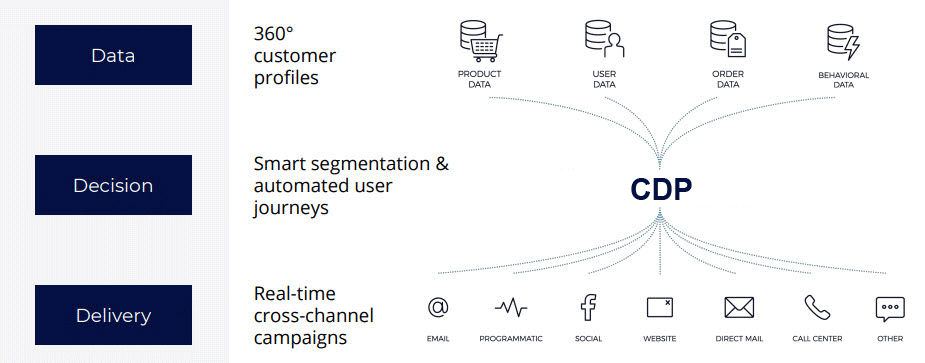
I have written about CDPs, especially the difference between a CDP, CRM and DMPs.
Because of technological advancements and the API-zation of MarTech, much more is possible than before. CDPs are built on Big Data platforms that can ingest all that customer data, and use it in real-time. Those technologies weren't even around 7 years ago. With the accompanied packaged features for data management, the CDP aims to create a full picture of the customer.
And that is still a thing. More than half of organizations rate their own marketing and customer experience approach to be disconnected. Only 10% finds their MarTech stack is tightly integrated, with Europe doing a bit worse than North America.
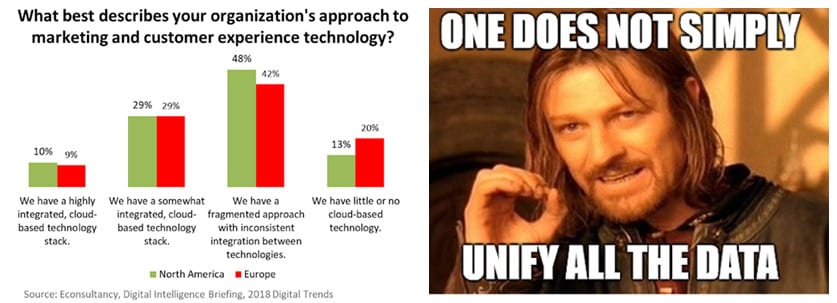
But wait... creating a customer profile or even a 360 customer view doesn’t bring any value by itself.
So what are the benefits of using a Customer Data Platform? and would you need one? Let's look at a case study that explains the value of connected data.
HelloFresh lost customer reactivation case
An example of a Customer Data Platform use case comes from Hellofresh. The HelloFresh food Box subscription service uses many channels. Facebook retargeting via custom audiences, Sendgrid for emails, Appboy for mobile push, Twilio for SMS, their own site(s) and integrated personalized offline letters using Optilyz. They wanted to connect these while keeping the current set-up.
Through the use of CDP they were able to coordinate the different channels, but also do cross-channel campaign testing. They tested several channels against each other and also different combinations (like the winning combination with email + direct mail). Just setting this up would have been an enormous effort without a CDP.
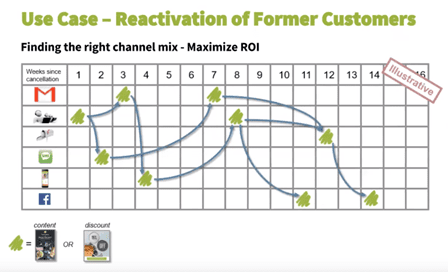
For a test like that, you need to have all the relevant customer data to build the right segments. Then, on the decision side, you have to select those segments and create test cells. Finally, on the delivery side, you send out the campaigns via the channels you want to test.
Then bring back the tracked conversions of the different channels and campaigns.
A CDP helps to do so, without the manual effort and while tracking the results for every user.
Overall, the integrated setup allows companies that have a CDP to easily find the right datasets for possible campaigns, then plan the right campaigns for an A/B/C/...-testing and measure the results.
Here is the case presented by CDP CrossEngage. Reactivate or rather win-back former customers and increase the effectiveness of a personalized direct mail.
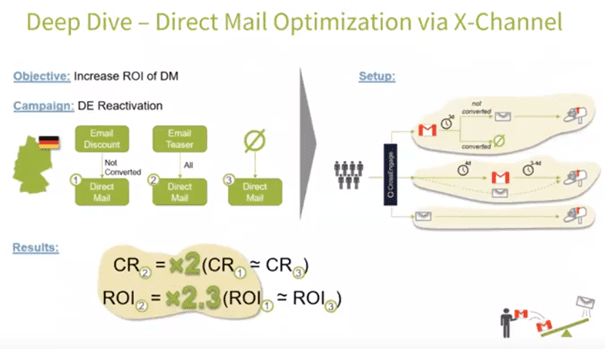
Sending an email teaser first doubles ROI and Conversion Rate of the direct mail. It makes sense that the results are better than a single Direct mail, but also much better than an email discount and direct mail after. Which makes the case for A/B testing different scenarios.
Still quite a simple campaign if you look at it like this, but automation requires that the all the data and the multiple execution channels here are communicating with each other.
Another finding was that young people react better to the direct mail moment than older. As a result, HelloFresh could optimize their campaign and send direct mails more often to younger people (and spend more budget on this audience).
In my eyes, the less complex you can keep your marketing campaigns, the better. And especially the first iteration of your campaign.
Benefits of unified customer data
Research by the CDP Institute showed that Personalization, Insights and cross-channel measurement rank as the most popular benefits for Unified Customer Data.
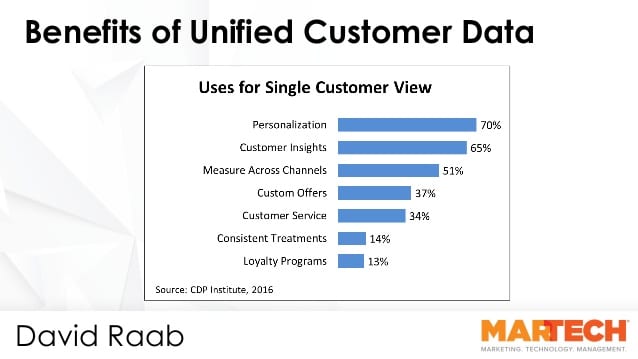
You could see why these would be beneficial to marketers. The numbers might be a bit slanted though, as the respondents could answer multiple uses. For instance, if you have a loyalty program (or thinking about one) obviously your would already need to connect all the program data and personalize.
Importance of Time to first Value and Data Activation
If you are trying to create a CDP business case, the Time to First Value is an important consideration. CDP implementation can be faster than custom, single point integrations. This is because of the built-in integrations and data management features. But the value is the use of the data, also called "Data Activation".
Start with one or two use cases that have a direct impact on profits and can be implemented quickly. This will help to increase internal support for the data-driven marketing as a whole. Then everything after that is gravy.
Later, the use-case can be built out, or more uses added. A first use case is often a lighthouse project. By having the infrastructure in place, the first project also has a signal effect for numerous follow-up projects.
Think about the maturity on dimensions a CDP offers:
- Level of personalization: from placeholders for names to individual website and email content as well as individual customer journeys
- Level of automation and refined Decisioning
- Level of segmentation: from big groups to almost 1:1 communication
- Data maturity: add more data points, from profile, product, and behavioral data to intent and value based.
- Add more touchpoints and channels for Cross-channel campaigns.
Begin with quick-wins so the CDP can pay for itself. The quick-wins come in different forms. Sometimes it is called a pilot, a Minimum Viable Product (MVP) or the use of the CDP in a single campaign. While the roadmap will be different - the stages look the same. Starting small with an implementation time of one to three months to reach first results.
Finding your use cases and the Benefits of a CDP
The benefits of a Customer Data Platform boil down your own use case(s). These will provide the value of the CDP. Yet there are some other benefits that go beyond the single use cases and more into the long-term vision of company data management.
1. Cross-channel attribution
While the current measurement and attribution maturity of your company might not demand it (yet). The Case of HelloFresh shows that running campaigns over multiple channels asks for a flexible reporting and attribution. The CDP will ready the organization for a more comprehensive view of the outcomes of Marketing activities and attribution across channels.
2. Agility and future-ready infrastructure
The only constant is change, is the famous quote. That is especially true with the ever-changing consumer behavior and changes in accompanying technology. Just think about the advent of Internet of Things and the changes in payments and store behavior.
A CDP is built to be a central hub to connect data sources and delivery platforms, where sources can be connected as they are introduced and use it anywhere to drive better customer experiences.
3. Democratization of Data
Traditional IT-managed databases have a built-in bottleneck (namely the IT resources). A CDP democratizes the access to customer data and lets the data be used directly by the departments that generate the associated value. Marketing, customer service, business intelligence, they all depend on the access to the data and customer touchpoints.












